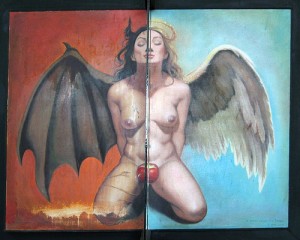A story of how evil came about in the world…

A long time ago, there was a small tribe living in a forest. These people were special because they were the very first, and only people of the earth. They were joyous humans that showed kindness towards one another, and showed much respect to the earth they lived on. The tribe possessed magical abilities and were able to speak with nature, and were very tuned into their surroundings. They possessed all their needs; an abundance of food, warmth from the sun, the purest and freshest water, and showed much love for one another. These people lived with happiness, and were grateful for everything in their lives. Every month, a week before the full moons took set in the sky, the tribe would tell stories, up until the evening of the full moon. Once the full moon was up, lighting the sky, they would dance, sing, laugh, rejoice, and praise the good in their lives.
One evening, the eldest woman of the tribe decided to tell a tale to her peers. This tale was only told once, when she was a little girl, by her eldest grandmother.
“One evening, a long time ago, while preparing for a full moon dance, a young man wandered into the woods to gather berries to make face paint. While gathering berries, he heard a whisper in the wind. He listened carefully, as he stood still. The whisper warned him of a dark energy, a matter in which was unknown to this people and the earth on which he lived. This dark energy came from a different world, an underworld, from a far away distance of the universe, and was headed to his people’s earth – it would not bring good, it would bring grief and horror. The young man felt an emotion he terror, a feeling he had never felt before.
“It will first come to the earth disguised in poisonous plants, be cautious”, the whisper said. “Stay away from these plants. They will look delicious to eat and smell sweet. Do not eat these plants, and do not be fooled.” The whisper in the wind started to fade away. “You have been warned…”, the whisper in the wind faded away.
The young man had so many questions, he did not know of any dark energy, he was not familiar with anything that caused harm to his people, and had never heard of poisonous plant. His people could eat any of the plants in their forests. Stunned, the young man quickly gathered his berries and ran back to his people. Once he arrived to the grounds of his tribe, he could see his peers laughing, and signing. They were all wearing their full moon regalia, and were full of joy and happiness. The young man was unsure of what to do. He did not want to spoil the ceremony, nor did he want to scare his people and share what he had just learned. He decided to tell only one person; his auntie. His auntie was a wise women, and a shaman. He searched for her through the grounds, and found her placing a head dress over her long, dark hair.
“Auntie, I have news for you”, he said to his auntie, with her back facing him as she groomed herself for the ceremony. “I heard a whisper in the wind, it warned me of a dark energy, that will bring havoc to our people, an energy from a far away place, the whisper said it will hide in the sweet forest plants. If we eat these plants, grief will happen – ”
“Hush”, said the wise woman, as she turned to face her nephew. The young man was silent, scared, and restless. “I know of dark energy. It is called evil. The whisper in the wind warned me, too. Our people will be prepared for this, child, do not worry.” The wise woman spoke with a serious tone, but her words brought comfort to the young man. “We do not speak of this, child. If we speak of this, we invite the dark energy into our world.”
“I am worried our people will be fooled with the poisonous plants for food, and grief will happen”, said the young man.
“We have intuition. Our people feel what is right, and what is not right. We will know, we will not be fooled”, affirmed the wise woman. “We do not speak of this, ever. This is scared knowledge, keep it in your possession.”
The young man was re-assured, his auntie knew much about the world, and her wisdom and knowledge had always guided their people. The young man continued making face paint for the ceremony, and kept the words of the wind to himself.
Time went on, and days turned to months, while months turned to years. The young man was no longer a young man, he was a wise man, a shaman. He was now an elder of his tribe. One day, in preparation for a full moon ceremony, his people were laughing, singing and sharing each others’ joy. The wise man slowly walked and observed his people with love, and gratitude. He watched as the children played, as the daughters and mothers sang, and as the men beat their drums. All of his people were dressed in their ceremonious regalia, with painted faces and smiling expressions. As the wise man walked slowly, he halted in his steps. He saw one of his young men, sitting and watching the others. The wise man carefully looked into the young man’s spirit. He felt something was not right. The young man’s eyes were not joyous, they seemed like a cougars’ eyes before slaying a prey. The wise man felt an emotion he had not felt in a long time; terror. The wise man made his way to the young man, and grabbed his arm, pulling him out of sight from the others. The wise man faced the young man, starring into his eyes; he could smell sweetness from the young man’s breath. A sweetness that only came from plants. The wise man knew what had happened – dark energy, or evil, had entered their world, and was dwelling in the young man’s spirit.
Over the weeks, the young man became violently ill. He was coughing his insides out, and had the life sucked out of him. He became weak, and his skin displayed red spots and dots. The wise man did his best to keep the evil away from the young man’s spirit, but the dark energy was stronger than their magic, and had penetrated into their world. The dark energy had taken the young man away. Over the weeks, the wise man’s people started becoming ill, showing the same signs as the young man. Many of the wise man’s people were helpless. The dark energy was a forced much stronger than their own, and had come into their world of peace and happiness.
Works Cited
1) First Nation’s Health Authority. Our History, Our Health. Web. 28 May 2015. <http://www.fnha.ca/wellness/our-history-our-health>
2) Locke, Sherrie. The First Full Moon of 2015. World Press. January 2015. Web. 29 May 2015. <https://psychicreadingstarot.wordpress.com/2015/01/03/the-first-full-moon-of-2015/>
3) NNL-News. Anishnawbe Mushkiki Full Moon Shares Tradition. NNL: Net News Ledger. 29 December 2012. Web. 29 May 2015. <http://www.netnewsledger.com/2012/12/29/anishnawbe-mushkiki-full-moon-ceremony-shares-traditions/>



